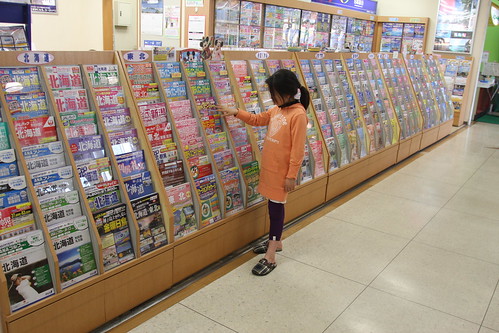Tuesday, April 17, 2012
Tours Galore: The Variety of Japanese Domestic Tourism
There are about 180 different domestic package tours being offered by this travel agent. That the Japanese use group tours is sometimes argued to be indicative of Japanese social conformism (Graburn, 1983; Mak, 2003; Kato, 1994) and collectivism.
It can also be argued on the contrary (e.g. Hendry & Raveri, 2002) that Japanese leisure activities demonstrate the myth of Japanese homogeneity, and I agree. Just look at the choice available here and this is just domestic tourism. Furthermore, as Hendry (Hendry, 2009. p132) points out, with all the foreign country themed parks, it is possible to do a fantasy world tour with out leaving Japan. The variety of Japanese leisure activities are phenomenal.
A package tour does not necessary imply that one travels in a group only that the tour operator has purchased the elements of the package in bulk. As soon as one gets off the plane, bus, or train, one may act individually, almost unaware of the fact that there are others that have rooms at the same hotel, or tickets to the same museums.
It is true that the Japanese are more likely to go on package tours than American tourists, but there are more advantages to travelling in groups than collective conformism. No matter which way you cut it, package tours offer economies of scale (Mak, 2003) so unless you are so obsessed with "expressing your individuality", (Markus, Uchida, Omoregie, Townsend, & Kitayama, 2006) or have such fear of the collective, that you are prepared to pay through the nose to avoid a group tour, the straightforward individual who is not hung up on her individuality, will choose a package tour that suits her preferences because packages are cheaper, and Japanese tour operators offer variety in abundance.
Bibliography
Graburn, N. H. H. (1983). To pray, pay and play: the cultural structure of Japanese domestic tourism. Université de droit, d’économie et des sciences, Centre des hautes études touristiques.
Hendry, J., & Raveri, M. (2002). Japan at play: the ludic and the logic of power. Routledge.
Kato, A. (1994). Package tours, pilgrimages and pleasure trips’. The Electric Geisha: Exploring Japan’s Popular Culture. Tokyo: Kodansha International.
Mak, J. (2003). Tourism and the Economy: Understanding the Economics of Tourism. University of Hawaii Press.
Markus, H., & Kitayama, S. (1994). A Collective Fear of the Collective: Implications for Selves and Theories of Selves.
Markus, H. R., Uchida, Y., Omoregie, H., Townsend, S. S. M., & Kitayama, S. (2006). Going for the Gold Models of Agency in Japanese and American Contexts. Psychological Science, 17(2), 103–112. doi:10.1111/j.1467-9280.2006.01672.x
It can also be argued on the contrary (e.g. Hendry & Raveri, 2002) that Japanese leisure activities demonstrate the myth of Japanese homogeneity, and I agree. Just look at the choice available here and this is just domestic tourism. Furthermore, as Hendry (Hendry, 2009. p132) points out, with all the foreign country themed parks, it is possible to do a fantasy world tour with out leaving Japan. The variety of Japanese leisure activities are phenomenal.
A package tour does not necessary imply that one travels in a group only that the tour operator has purchased the elements of the package in bulk. As soon as one gets off the plane, bus, or train, one may act individually, almost unaware of the fact that there are others that have rooms at the same hotel, or tickets to the same museums.
It is true that the Japanese are more likely to go on package tours than American tourists, but there are more advantages to travelling in groups than collective conformism. No matter which way you cut it, package tours offer economies of scale (Mak, 2003) so unless you are so obsessed with "expressing your individuality", (Markus, Uchida, Omoregie, Townsend, & Kitayama, 2006) or have such fear of the collective, that you are prepared to pay through the nose to avoid a group tour, the straightforward individual who is not hung up on her individuality, will choose a package tour that suits her preferences because packages are cheaper, and Japanese tour operators offer variety in abundance.
Bibliography
Graburn, N. H. H. (1983). To pray, pay and play: the cultural structure of Japanese domestic tourism. Université de droit, d’économie et des sciences, Centre des hautes études touristiques.
Hendry, J., & Raveri, M. (2002). Japan at play: the ludic and the logic of power. Routledge.
Kato, A. (1994). Package tours, pilgrimages and pleasure trips’. The Electric Geisha: Exploring Japan’s Popular Culture. Tokyo: Kodansha International.
Mak, J. (2003). Tourism and the Economy: Understanding the Economics of Tourism. University of Hawaii Press.
Markus, H., & Kitayama, S. (1994). A Collective Fear of the Collective: Implications for Selves and Theories of Selves.
Markus, H. R., Uchida, Y., Omoregie, H., Townsend, S. S. M., & Kitayama, S. (2006). Going for the Gold Models of Agency in Japanese and American Contexts. Psychological Science, 17(2), 103–112. doi:10.1111/j.1467-9280.2006.01672.x
Labels: collectivism, individualism, japan, japanese culture, nihobunka, nihonbunka, 個人主義, 日本文化, 集団主義
This blog represents the opinions of the author, Timothy Takemoto, and not the opinions of his employer.

